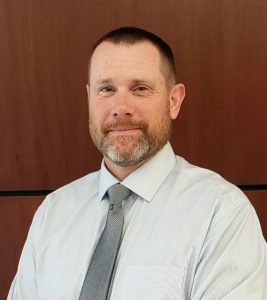The Construction Site Safety Tour
By Eric Hadlock
 Recently I had the opportunity to spend an afternoon with a gentleman who had expressed an interest in a career change to construction safety. This man had spent significant time in another field very different from the construction industry. He stated that he was looking for a new challenge in his life and has always been fascinated watching construction projects progress from a distance and thought he would like to become part of the process. Bringing a strong belief in safety, his goal is to embrace a role in this field. I had been asked to spend time and explain the responsibilities of a safety manager and point out what to look for during a site visit. I also wanted to explain how a safety manager communicates and works with site leaders and personnel to facilitate a safe work site. Being new to my role at Welliver, I was excited to bring a fresh perspective to our discussion.
Recently I had the opportunity to spend an afternoon with a gentleman who had expressed an interest in a career change to construction safety. This man had spent significant time in another field very different from the construction industry. He stated that he was looking for a new challenge in his life and has always been fascinated watching construction projects progress from a distance and thought he would like to become part of the process. Bringing a strong belief in safety, his goal is to embrace a role in this field. I had been asked to spend time and explain the responsibilities of a safety manager and point out what to look for during a site visit. I also wanted to explain how a safety manager communicates and works with site leaders and personnel to facilitate a safe work site. Being new to my role at Welliver, I was excited to bring a fresh perspective to our discussion.
The man expressed that he was interested in learning what happened on a construction project on a daily basis and how something that looked so hectic from afar could be done safely. After initial introductions and a safety briefing that covered the potential hazards of our active construction site tour, I ensured he had the required Personal Protective Equipment (PPE) — hard hat, safety glasses, high visibility vest, and proper footwear — all required on our construction sites. We spoke briefly about the scope of the project that we were about to walk through and headed out the door.
As we started to walk the site, he asked if I had always been involved in construction safety. Interestingly, I too made a change into construction safety after recently retiring from law enforcement. Although the two careers are very different, there are also many similarities between law enforcement and construction safety. Both are governed by a set of rules or regulations (laws and OSHA regulations), require an attention to detail after understanding the rules and a willingness to enforce those rules, require an ability to effectively communicate and most importantly, have the ultimate goal of keeping people safe. In construction that means both on the job site (the worker) and anyone adjacent to the job site (the public).
As we continued our walk through, I pointed out what to look for relative to risks, hazards, and unsafe conditions while pointing out the relevant OSHA regulations and the importance of following them. I emphasized that OSHA regulations are bigger than just “following the rules.” I have learned that many of the decisions that humans make regarding rules are governed by consequence avoidance, and in fact, are at the simplest level, a cost/benefit analysis. OSHA can certainly level severe financial consequences for not following their rules (cost), but the OSHA regulations are far bigger than that. The most obvious benefit of implementing programs to ensure OSHA compliance is a safe work site; a site free from recognized hazards that are likely to cause serious harm (the General Duty Clause). I explained that construction is an inherently dangerous profession, but the OSHA regulations helped mitigate the hazards. It has become very clear that adhering to OSHA regulations requires a great deal of organization and planning. Everyone must think through a task and anticipate the potential hazards. Many of the OSHA regulations help streamline that process by focusing on known hazards in almost all aspects of construction, and in many cases outline the equipment and training needed to maintain safety. Yes, there are a lot of numbers, measurements, tables, weights, heights, etc. to be aware of, but the result is a well thought out plan with a focus on worker safety.
Another benefit of a safe work site is a more productive work site. A safe and productive work site that incorporates effective communication and teamwork fosters increased morale. I don’t know a single enterprise involving more than one person that does not benefit from increased morale. Although that benefit is immeasurable, it is wildly apparent when morale is poor. All of this has financial benefits as well; on-time or ahead of time completion dates, lower injury (recordable/reportable) rates resulting in lower insurance costs, and most likely reduced overall construction costs. A safe and productive construction job site extends beyond your employees as subcontractors also see the benefits. Adhering to the OSHA regulations is important, but the benefits are far beyond just checking a box on a checklist.
As we made our way back to the job site trailer to conclude our tour, we discussed the balance between construction task completion and safety. In my mind, they are ultimately the same thing. There can be no division between construction and safety. Each and every task and subtask must be thought out, planned, and resourced while integrating safety. We do not do construction tasks discretely from safety – every construction task must be done safely in order to be done correctly. Our goal every day is to accomplish the tasks required to meet the goals of our customers (project owners), but just as important, to ensure all our workers walk off the project sites in at least as good a condition as they walked on. If we do that, we are all successful.
Back in the trailer, I knew he had fully grasped the message I was trying to convey when he summed up our tour. He said, “if I have understood you correctly, Construction Safety is the same thing as Construction Safely.” When I thought about it, he hit the nail on the head.
Eric works hard to establish and promote a worksite where safety is at the forefront and successful project completion is the outcome. With every project he instills a common philosophy – we must take care of each other. As Welliver’s Project Safety Director, Eric continuously challenges himself to look for better and more efficient ways to improve the safety environment that will positively impact the lives of all on the project site. He creates an environment of personal accountability and plays an integral role in maintaining Welliver’s position as a leader in workplace safety. Eric can be reached at [email protected].






 The aftermath of the COVID-19 pandemic has changed America in many unforeseen ways. With that in mind, it has also jettisoned the economy into difficulties that no one could have predicted prior to the onset of the pandemic. This has definitely included the world of K-12 school construction. School districts across the country are in the midst of implementing or developing facilities projects and the state of the economy and the specific types of challenges we are facing must be considered. This is where Construction Managers (CM) like Welliver show their true value. In this era we have heard the word “pivot” used across disciplines in terms of adapting to this ever changing world. At Welliver, we are currently at the table and in the field working with our clients helping to make their dollars stretch as far as possible and helping school districts “pivot” where necessary to ensure projects are successful.
The aftermath of the COVID-19 pandemic has changed America in many unforeseen ways. With that in mind, it has also jettisoned the economy into difficulties that no one could have predicted prior to the onset of the pandemic. This has definitely included the world of K-12 school construction. School districts across the country are in the midst of implementing or developing facilities projects and the state of the economy and the specific types of challenges we are facing must be considered. This is where Construction Managers (CM) like Welliver show their true value. In this era we have heard the word “pivot” used across disciplines in terms of adapting to this ever changing world. At Welliver, we are currently at the table and in the field working with our clients helping to make their dollars stretch as far as possible and helping school districts “pivot” where necessary to ensure projects are successful.